Are you a Quiet Speculation member?
If not, now is a perfect time to join up! Our powerful tools, breaking-news analysis, and exclusive Discord channel will make sure you stay up to date and ahead of the curve.
There's a reason that stories tend to follow a certain structure. And similarly why studios seem to favor reboots and retreads over actually new movies. Humans are creatures of expectation and habit. We are used to certain things happening a certain way, especially once they've been socially reinforced, and when those expectations aren't met it creates tension and anxiety. Which is a long-winded way of saying that since I implied that this article could exist, I've created an expectation for it to exist. And will now follow through.
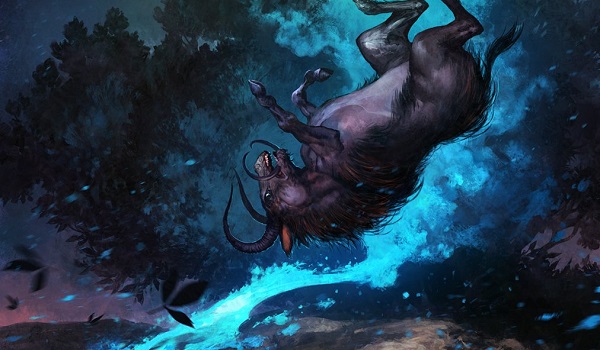
What Is Overplayed?
By arguing that certain cards are underplayed in the current metagame, I implied that there are also some being overplayed. Which is true. However, it's a problem for me. Explaining the underplayed cards is relatively easy: there are specific problems in Modern that have solutions which are seeing reduced or nonexistent play. An overplayed card requires more defining. Seeing a lot of play doesn't make a card overplayed. That's just popular. Rather, there needs to be a mismatch between the card's expectations and performance. And that is quite subjective. Everyone has have different expectations and thus how they evaluate a card will be different. Which is my cue to remind everyone that this is my list. These are the cards that I think are most underwhelming and consequently overplayed.
Definitions
And for me, the key is whether a card does what it's supposed to do. What I mean is whether an answer card actually answers the thing it's supposed to answer in the needed way. For example, playing Remand in a control strategy would be an inappropriate use, since it kicks the can down the road. Lots of true control running Remand would  therefore constitute overplaying. A tempo deck using Remand is appropriate since all it wants is to delay the opponent. Lots of fish style decks with Remand is not overplaying.
therefore constitute overplaying. A tempo deck using Remand is appropriate since all it wants is to delay the opponent. Lots of fish style decks with Remand is not overplaying.
With creatures it's a little harder. Most decks need to attack for the win and so a creature is never fully useless. Stats are also a really great way to manage expectations about what a card can actually do. Thus, an overplayed creature needs to be showing up where it doesn't belong. If something seems to be played everywhere because "it's too good not to be," "for value," or is otherwise "a free include" (actual explanations I've received) but doesn't really fit with the strategy. Or it doesn't actually do the thing it's hyped up to do. Or even worse, there are other cards that do its specific job better. If a creature is supposed to be overpowering and has to be played to be competitive, it had better actually be game ending in all contexts rather than just above average or a good rate.
Standards
Now that I've established how I define an overplayed card, I need to set out actual standards for evaluating the cards. This is particularly important given the subjective nature of this topic. However, it's also important to keep everything in context. I'm not evaluating these cards in a vacuum. Were that the case, this list would be quite different. 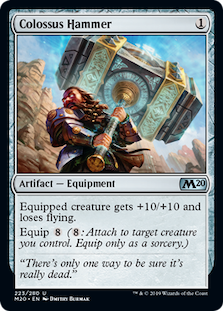 Instead, we'll focus on which cards are currently seeing play in the decks that also see play and don't make sense to me. To make my list, the card needs to be a combination of out of place and ineffective in the metagame as it's developing. My perception is based on what I'm seeing in the metagame data, watching others explore Modern, and my own experiences.
Instead, we'll focus on which cards are currently seeing play in the decks that also see play and don't make sense to me. To make my list, the card needs to be a combination of out of place and ineffective in the metagame as it's developing. My perception is based on what I'm seeing in the metagame data, watching others explore Modern, and my own experiences.
The July metagame update is out next week, and unless something changes dramatically this week, the meta will be split between Hammer Time and UR decks. The largest grouping of said UR decks is UR Thresh, using counterspells, removal, and cantrips to support a small number of cheap threats plus Murktide Regent. BR Stompy decks built around Lurrus of the Dream-Den are another big player, while most of the combo space is cascade decks. There's a few control decks making a case, but for the most part, right now Modern looks like the fairer side of Legacy. This is the reality that I'm establishing and evaluating my standards under.
Inefficacy in Context
How easily does a card do what it's supposed to in the current deck/metagame? Last time I was just looking at how effective a card was at its job. No ifs, ands, or buts; simply, does it do what players want and expect it to do? However, to evaluate an overplayed card requires additional context. Given how the metagame is working and what is seeing play, does the 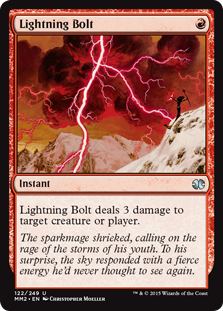 card actually do what it's supposed to do? Will the card's intended primary function actually come up during games often enough to justify playing the card? And if it does, can the deck playing it make use of the effect to full impact? If the answer isn't yes to all those questions, the card needs to be questioned.
card actually do what it's supposed to do? Will the card's intended primary function actually come up during games often enough to justify playing the card? And if it does, can the deck playing it make use of the effect to full impact? If the answer isn't yes to all those questions, the card needs to be questioned.
For example, Lightning Bolt has arguably been the defining card of Modern since the format's inception. It is the best there is at what it does for its price, and Modern has always had use for three damage to anything for one red mana. However, its relative stock has risen and fallen over the years as the metagame has changed. For example, in 2016 37% of decks played Bolt, but in 2017 if fell to 27%. That was the year that Eldrazi Tron and Death's Shadow took over Modern and Bolt was no longer effective removal. In 2018 Humans was the top deck; Bolt was effective again, and 35% of decks played Bolt. The inherent power of Bolt never changed, just its contextual power. A card being ineffective in context doesn't make it bad, just not the right call.
Parasitism
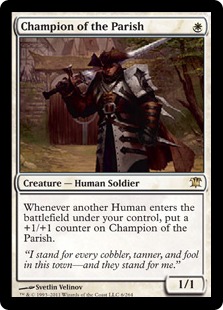 Does the card stand on its own or require help? A card that is good by itself in a wide variety of contexts is no parasite. However, if a card absolutely needs others to be good, let alone playable, then it is one. This isn't a problem by itself, as tribal cards are inherently parasitic and there's no issue with their playability. The problem comes when a card is a parasite but the parasitism isn't obvious. Champion of the Parish is highly parasitic but nobody would ever run it without support, meaning it will only see play in the right context. Thus, it wouldn't meet my definition of overplayed.
Does the card stand on its own or require help? A card that is good by itself in a wide variety of contexts is no parasite. However, if a card absolutely needs others to be good, let alone playable, then it is one. This isn't a problem by itself, as tribal cards are inherently parasitic and there's no issue with their playability. The problem comes when a card is a parasite but the parasitism isn't obvious. Champion of the Parish is highly parasitic but nobody would ever run it without support, meaning it will only see play in the right context. Thus, it wouldn't meet my definition of overplayed.
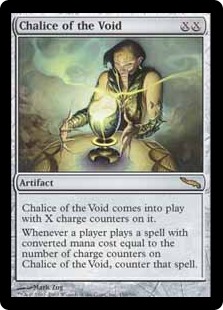 Conversely, Chalice of the Void doesn't need much support from its own deck to do its thing. However, its only meaningful in the context of the opponent's deck, which is still parasitic in the technical sense. This is where problems can arise. If a card is only good against a certain card or deck and does nothing by itself, it has parasitic qualities.
Conversely, Chalice of the Void doesn't need much support from its own deck to do its thing. However, its only meaningful in the context of the opponent's deck, which is still parasitic in the technical sense. This is where problems can arise. If a card is only good against a certain card or deck and does nothing by itself, it has parasitic qualities.
Another example: Authority of the Consuls is highly parasitic in this regard, since it does absolutely nothing against creatureless decks. Even against decks with creatures, its main ability only really matters against decks with haste creatures. Unless you intended to use Authority to sneak damage through new blockers, it's a negatively parasitic card. These can very easily be overplayed because they need the opponent to play ball to be good. And what if said opponent says no?
Opportunity Cost
What alternative is being sacrificed for this card? Simply put, how is the selected card better 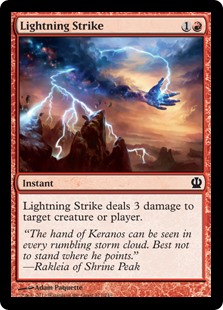 than the alternative? No card is ever actually a free include. There's always an alternative that could be played and therefore there is always an opportunity cost to every card. However, a card with a low opportunity cost will either have few alternatives or be significantly better than said alternatives. For a high one, the opposite is true. To wit: the opportunity cost of Lightning Bolt is its alternative, Lightning Strike (same effect, different cost). As Bolt is cheaper, that opportunity cost is very low. However, in the context of removal spells, Bolt may be quite high, as there are a wide range of one-mana kill spells and depending on metagame context, it may prove expensive to include Bolt over something else.
than the alternative? No card is ever actually a free include. There's always an alternative that could be played and therefore there is always an opportunity cost to every card. However, a card with a low opportunity cost will either have few alternatives or be significantly better than said alternatives. For a high one, the opposite is true. To wit: the opportunity cost of Lightning Bolt is its alternative, Lightning Strike (same effect, different cost). As Bolt is cheaper, that opportunity cost is very low. However, in the context of removal spells, Bolt may be quite high, as there are a wide range of one-mana kill spells and depending on metagame context, it may prove expensive to include Bolt over something else.
Force of Negation: 9/15
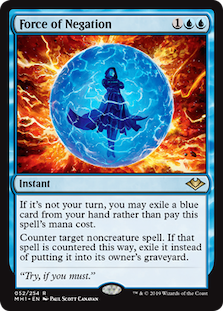 Force of Negation is a good card, and at times it has been a necessary card. It's the most flexible free counterspell in Modern. Disrupting Shoal never saw much play because it's hard to use. So Force is the only means most decks have of protecting themselves against opponent's the turn they tap out. This is very important against control and combo decks. The problem is that Force is only actually free on the opponent's turn. Even then, you only want to counter really important spells, and only if absolutely necessary. There's a reason that Force of Will gets cut in fair matchups in Legacy.
Force of Negation is a good card, and at times it has been a necessary card. It's the most flexible free counterspell in Modern. Disrupting Shoal never saw much play because it's hard to use. So Force is the only means most decks have of protecting themselves against opponent's the turn they tap out. This is very important against control and combo decks. The problem is that Force is only actually free on the opponent's turn. Even then, you only want to counter really important spells, and only if absolutely necessary. There's a reason that Force of Will gets cut in fair matchups in Legacy.
Inefficacy in Context: 3
The ideal Force targets are planeswalkers or combo pieces, preferably ones that cost three or more to offset Force's mana cost or card disadvantage. The most played noncreature spells at the moment are all cheap instants and sorceries. Sometimes Forcing an Expressive Iteration or Prismatic Ending is necessary. Doesn't feel very good, though. Forcing Chalice of the Void is a valid and good use of Force, and Ad Nauseam and Tron are still seeing play. However, Force is fairly mediocre against the cascade combo decks because Violent Outburst lets them combo off on end step when Force isn't free. It does what it does, it just doesn't happen as much as it used to, and Force's limitations are an issue.
Parasitism: 3
Answer cards are naturally parasitic. They're answers, so they need questions to have meaning. Force is a Negate variant, which makes it more parasitic because it's more narrow. It gets worse since casting Force for free (the reason to play the card) requires another blue card in hand. Doing what's necessary is necessary, but that does also create deckbuilding and gameplay requirements.
Opportunity Cost: 3
The fact that Modern has few free counters brings down Force's opportunity cost. Having to hold another blue card in hand raises the cost since that card can't be used for its intended purpose. However, the real problem with Force is the deckspace cost. There are many alternatives if the only goal is to protect against noncreature spells on the opposing turns for cheap, including Veil of Summer and Spell Pierce. That being the main intention raises the cost. Additionally, playing Force means less space for cards that answer creatures in a Modern, where answering creatures is far more important than answering spells.
Sanctifier en-Vec: 10/15
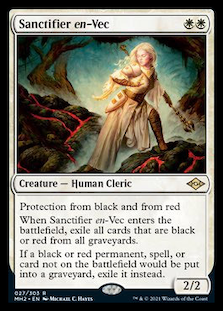 I like Sanctifier en-Vec. However, players have taken to playing it instead of Rest in Peace in decks that formerly ran Rest. The thinking is that all the cards that most decks want to exile are red, because they're thinking of Dragon's Rage Channeler decks. Having a protection from red creature is really good against those decks, so Sanctifier does the job of Rest and Auriok Champion, freeing up sideboard space. The catch is that Sanctifier doesn't actually answer Dragon's Rage Channeler because it can't exile artifacts, lands, or blue cards. And that's not even considering white and green decks.
I like Sanctifier en-Vec. However, players have taken to playing it instead of Rest in Peace in decks that formerly ran Rest. The thinking is that all the cards that most decks want to exile are red, because they're thinking of Dragon's Rage Channeler decks. Having a protection from red creature is really good against those decks, so Sanctifier does the job of Rest and Auriok Champion, freeing up sideboard space. The catch is that Sanctifier doesn't actually answer Dragon's Rage Channeler because it can't exile artifacts, lands, or blue cards. And that's not even considering white and green decks.
Inefficacy in Context: 3
Against the decks that most players are thinking about, Sanctifier is quite strong. The problem is that they're not the whole metagame and Sanctifier is worthless against Emry, Lurker in the Loch, Lurrus, and Living End decks. Decks which are as prevalent in aggregate as the DRC decks.
Parasitism: 3
Sanctifier is a color hoser. Those are very parasitic, even when attached to reasonable stats on a good creature type. It's also a graveyard hate card, which is relevant often but not always.
Opportunity Cost: 4
The cost of playing Sanctifier is Rest in Peace. Sanctifier being overplayed is in fact the reason that Rest is being underplayed. In a deck like Humans, the cost is low because Humans never ran Rest. For the Stoneblade and control decks I've seen running Sanctifier, it is a high cost. Particularly because the majority I've seen aren't running any graveyard synergies themselves.
Ragavan, Nimble Pilferer: 10/15
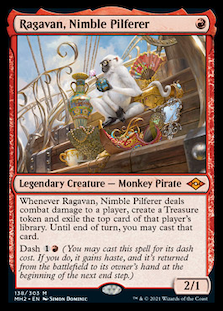 The most hyped red one-drop from MH2 was Ragavan, Nimble Pilferer. The most played one has proved to be DRC. It may be this hype and the dream of stealing opposing cards which has led many players to run Ragavan in decks that cannot support him. And Ragavan needs a lot of support.
The most hyped red one-drop from MH2 was Ragavan, Nimble Pilferer. The most played one has proved to be DRC. It may be this hype and the dream of stealing opposing cards which has led many players to run Ragavan in decks that cannot support him. And Ragavan needs a lot of support.
Inefficacy in Context: 2
If the statlines and dash were the only metric, then Ragavan would be worse than Zurgo Bellstriker, because Zurgo doesn't die to Lava Dart, Wrenn and Six, and Gut Shot. Zurgo seeing no play would indicate Ragavan would be very ineffective. However, making treasure is a very useful ability, and is the real reason that Ragavan sees play. Getting to play opposing spells is more of an occasional reward than a point in Rags's favor.
Parasitism: 5
However, dying to everything and needing to successfully deal combat damage is Rags's failing. He's very strong in decks that play lots of removal, disruption, and/or other cheap creatures to clear a lane to actually connect. If that isn't the case, he's just removal bait, and that's the problem: I'm increasingly seeing decks that can't actually protect or clear space for Rags play him. Rags is very bad without a lot of help.
Opportunity Cost: 3
On the one hand, cheap aggressive creatures is very low cost because winning the game is good. However, in the slower decks I see Rags infiltrating, he's taking the place of removal, bigger threats, and/or reliable card advantage, all things these decks absolutely need and must closely monitor their budget for.
Grief: 13/15
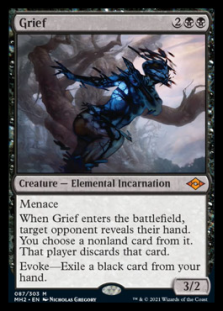 I've been skeptical of Grief since it was spoiled. Modern as a whole seems to agree with my skepticism. Where initially Grief saw widespread play, it has drastically narrowed to WB Stoneblade and Living End. The Stoneblade decks are contorting themselves silly to make Grief work and still floundering in the metagame standings.
I've been skeptical of Grief since it was spoiled. Modern as a whole seems to agree with my skepticism. Where initially Grief saw widespread play, it has drastically narrowed to WB Stoneblade and Living End. The Stoneblade decks are contorting themselves silly to make Grief work and still floundering in the metagame standings.
Inefficacy in Context: 3
In Living End, Grief is a good card because it protects and opens a road for the combo while synergizing with the payoff. Everywhere else, Grief is a free but card disadvantageous Thoughtseize, a card whose own stock has fallen relative to past years (and not, I would guess, because it's too expensive to cast).
Parasitism: 5
Grief is only good when its card disadvantage gets made up. This is why it doesn't see play in tribal Elementals very much. This is no problem for Living End. However, every other deck is going to ridiculous lengths to try and live the dream of turn 1 Ephemerate on Grief. The card is making decks warp themselves to better serve it, but doesn't reward them with Challenge or Preliminary results. Making a host serve its interests and not the hosts is textbook parasitism.
Opportunity Cost: 5
Stoneblade has been cutting Thoughtseize and Inquisition of Kozilek to run Grief. Those cards don't put the same pressure on deckbuilding as Grief, have lower mana costs, and don't generate card disadvantage early. That's a max-cost situation there.
Aether Gust: 15/15
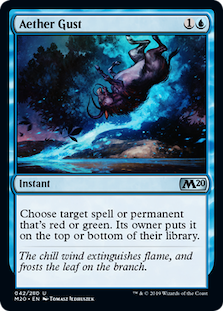 It was watching a UW Control deck Aether Gust a Primeval Titan three times and then die once it resolved that got me thinking about overplayed cards in the first place. Gust is a tempo card that somehow mostly sees play in non-tempo decks, primarily control decks. Which want to permanently remove things, not delay them to be answered again. Were Gust seeing play in UR, there'd be no problem. But it's the high control play that earns Gust it's spot.
It was watching a UW Control deck Aether Gust a Primeval Titan three times and then die once it resolved that got me thinking about overplayed cards in the first place. Gust is a tempo card that somehow mostly sees play in non-tempo decks, primarily control decks. Which want to permanently remove things, not delay them to be answered again. Were Gust seeing play in UR, there'd be no problem. But it's the high control play that earns Gust it's spot.
Inefficacy in Context: 5
Unless the opponent is stupid, they're not Gusting that Titan to the bottom of their library. This is the main way I've seen players use Gust in Modern for the past two years. The best use is Gusting a resolved Dryad of the Ilysian Grove to fizzle Valakut, the Molten Pinnacle triggers. However, that need is at a low ebb, and instead I see a lot of control players Gusting against cantrip-heavy red decks. Control is all about buying time, but it also cares about card economy and having to spend several spells answering one is very suboptimal.
Parasitism: 5
To actually remove something important for good, Gust needs the opponent to put it on the bottom of their library. That's a parasitic line. Alternatively, the card could be removed from immediate concern via Field of Ruin, Thought Scour, or Ashiok, Dream Render. For an answer card to need other cards to actually answer something is highly parasitic.
Opportunity Cost: 5
By running Gust, control is deciding not to run a card that actually answers a red or green spell. The only reason they're doing that is Cavern of Souls naming Giant. Given how rarely the plan works out in my experience, it's as big a cost as possible. Pathing Titan and Dryad is almost always a better line than Gusting and hoping to... what exactly? Suddenly win in one turn?
Value Impact over Effect
The main thrust of these cards is players valuing a card effects or perceived effects over proven impact. We all get distracted by cool things, but that's a trap. Focus on what actually works in context, not just what you think works, or worse, what you want to work.




